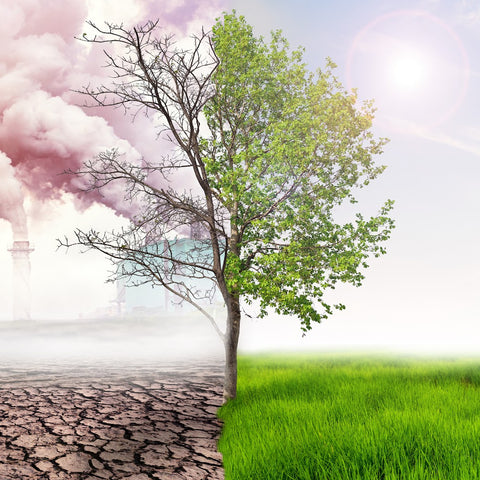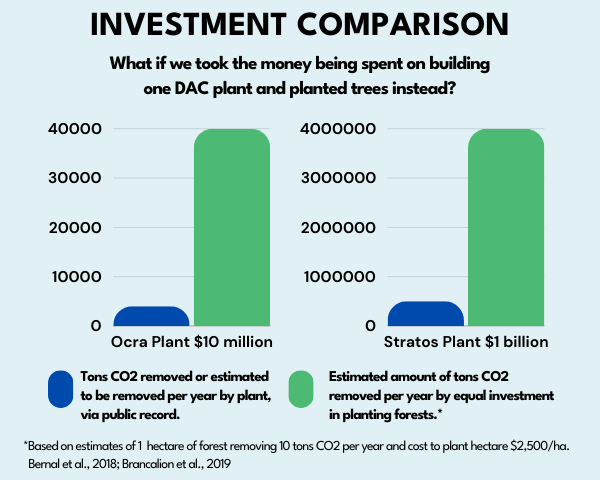Bill Gates vs Trees: A Clash of Perspectives

By Alena Miles
With Earth Day approaching, it’s the perfect time to discover, explore, and take action against climate change impacts.
The climate fight features big egos, big money, and big ideas. Which idea is "right" when it comes to saving the world? Let’s delve into the fascinating world of climate change mitigation strategies and explore why Bill Gates’ perspective on tree planting and direct air capture (DAC) has sparked debate.
“I Don’t Plant Trees”
Back in September, Bill Gates took some heat for his statements dismissing the idea that planting trees could combat climate change. In an interview with the New York Times on September 22, while discussing methods he supports to combat climate change, Bill Gates declared, “I don’t use some of the less proven approaches…I don’t plant trees.” When the interviewer mentioned that some say that if you just plant enough trees, it could take care of the climate issue, Gates replied, “that’s complete nonsense, I mean, are we science people or are we idiots?”
Gates claimed that instead of "unproven" methods like planting trees, he prefers carbon taxes and technologies such as carbon capture. Mr. Gates actively invests millions into direct air capture (DAC) projects through his investment firm Breakthrough Energy Ventures (BEV) and also through annual $10 million donations to the direct air capture carbon credit firm Climeworks.
Bill Gates made waves with these statements and sparked a debate over natural climate solutions vs. carbon removal technology.
Is reforestation nonsense, unproven, and unscientific?
Is direct air capture technology the miracle cure for climate change? Let’s take a deep dive!
 The Main Problem
The Main Problem
The truth is that humans have emitted so much CO2 into the atmosphere since the industrial revolution that curbing emissions will not be enough. In order to keep global temperatures livable, even if we stop all emissions today, we will still have to remove some of the CO2 that we have already emitted. In a 2018 report, the Intergovernmental Panel on Climate Change, said that in order to avoid the worst effects of climate change and limit global warming to 1.5°C, we need to remove between 100 and 1,000 gigatons of CO2 from the atmosphere. The World Resources Institute estimates that we would need to remove 5 to 16 billion tons of CO2 globally each year by 2050. This is why methods for carbon removal have become such an urgent topic.
Is Tree Planting the Only Solution?
As noted in the discussion with Mr. Gates above, detractors of natural climate solutions often begin their attempted takedown by saying that trees are not a miracle cure for climate change. However, this idea that planting trees will solve all of our problems is a construct of the detractors, a typical strawman argument. Of the hundreds of scientists, governmental agencies, dozens of studies, and many NGO’s who support the idea of reforestation and planting trees, none of them imply that it is a miracle cure. Reforestation efforts are described as being “a critical part of the solution," “among the most effective strategies," “a powerful set of options," and offering “valuable contributions.” Many state the obvious, that forests “cannot be a substitute for emission reduction.” The non-profit One Tree Planted confronts this misinformation head on in their article, “Is Reforestation the Silver Bullet for Climate Change?” Their answer, “Nope. We fully recognize that it should be considered in context of the bigger challenge at hand.”
Proponents of reforestation also acknowledge the challenges and limitations of tree planting. To achieve success, the right tree species must be planted in the right place and in the right way. There is a great deal of research regarding the best methods as well as new technologies in reforestation, such as FirePlug™ seedlings and the use of drones, satellite imaging, soil sensors, and more.
Is Tree Planting an “Unproven” Method?
It is a scientific fact that during photosynthesis, trees, other forest vegetation, and all plants take CO2 from the air and store it in their biomass, which includes their trunks, branches, stems, leaves, and roots. As it turns out, trees and forests are some of the best carbon sequestration systems in existence. The US Forest Service estimates that current U.S. forests capture over 800 million tons of CO2 per year which is about 12% of our annual emissions. We can also understand the power of forests’ carbon sequestration through the negative effects of deforestation. Scientists at MIT and others note that, to date, humans have destroyed 50% of all the forests on the planet. This accounts for 30% of all CO2 emissions since 1850.
Forests act as large carbon sinks, which remove and store vast amounts of CO2 that would otherwise contribute to carbon emissions. The United Nations reports that land-based natural ecosystems, just in the last ten years, have absorbed 30% of the excess carbon produced by humans. That’s a significant contribution to our efforts to curb climate change.
Other Benefits of Forests
Oxygen is needed for all living things on Earth, and forests release it into the air through photosynthesis. Along with reducing the effects of greenhouse gas emissions, this process helps preserve the balance of gases in the atmosphere. Forests are vital to our environment. They protect biodiversity, support wildlife habitats, keep the soil healthy, help capture water, prevent soil erosion, clean the air we breathe, remove pollutants, and help cool urban areas. Forests also prevent drought and promote rainfall. They help make the Earth a safe place to live and help prevent climate change.
Forests also have a strong social and health impact. Local communities and indigenous peoples in developing nations rely on forests for a variety of needs, including food, housing, medicine, and cultural practices, and the local economy benefits from these resources. Deforestation often displaces these communities, disrupting their traditional ways of life and threatening their food security and access to essential resources. By reducing deforestation, we can help ensure that these communities can continue to sustainably manage and benefit from the forests they have inhabited for generations.
The Potential of Trees
There are no questions regarding the fact that forests and trees remove significant amounts of CO2 from the atmosphere. The main debate in the scientific community is over the potential quantities of emission reduction that could be achieved and the cost and feasibility of reforestation efforts. Recent studies have suggested that global reforestation efforts could remove from 11 to 226 gigatons of CO2 per year. Other studies considering the potential in the U.S. alone estimate that forest restoration on available land could capture between 314 and 535 million tons per year.
Although a mass global reforestation effort would require great capital and human effort, forest restoration is low tech, cost efficient, scalable, and mutually beneficial to local communities. World Resources Institute estimates the cost of CO2 removal through reforestation to be less than $50 per ton.
Many countries have committed to reforestation programs, including the UK, India, Ethiopia, and China. China has already made great progress and offers a successful example. In the past 15 years, China has planted millions of trees, increasing the carbon sink of their forests, which is now offsetting 33% of China’s annual emissions. International reforestation efforts have been launched by many NGOs, such as the Bonn Challenge, where 59 countries have agreed to restore 150 million hectares of forest. Bill Gates’ fellow Silicon Valley billionaire Marc Benioff plans to plant one trillion trees, and over 300 companies have signed on. In the U.S., the Inflation Reduction Act commits $30 billion to natural climate solutions such as urban tree planting, climate smart forestry, and tree-focused practices such as Slilvopasture.
Forests can help stabilize Earth's climate by absorbing more carbon dioxide. Trees offer vital contributions to the climate crisis and human livelihoods. At Bold Botanica, we believe in trees and what they’ve accomplished for millennia to stabilize the climate and protect the Earth.

Nature vs Technology
Many people believe that technology will help solve climate change. It will likely take multiple strategies to remove excess CO2 from the atmosphere. One that's getting a lot of attention and investment is a relatively new technology, direct air capture (DAC). Can it be the innovation we've been looking for to remove CO2, or literally "scrub the air?" How does it compare with reforestation strategies?
Digging into DAC – How Does It Work?
DAC is touted as a leading climate change technology that literally cleans CO2 from the air. It works by capturing carbon dioxide from the air and then either storing it permanently or utilizing it for various applications.
The appeal of direct air capture is its ability to remove CO2 directly from the air around us. Traditional carbon capture technologies can only remove CO2 from specific sources, like power plants or factories. But direct air capture is supposed to allow us to capture CO2 anywhere.
DAC is marketed heavily as a way for any company to offset its negative emissions. And it is touted as the answer to “cleaning” the air in hard-to-decarbonize sectors.
The DAC Dilemma: Financial & Energy Burden
While somewhat promising, DAC relies on complex machinery, high heat and chemical processes. It is expensive to implement and maintain and requires high energy inputs for both.
Building and operating DAC facilities require substantial investment. The cost per ton of captured CO2 is significantly higher than tree planting. According to a white paper published by Microsoft, the cost of direct air capture is more than 50 times the cost per metric ton of most natural climate solutions.
While the industry does not offer much financial transparency, we know that Heirloom raised $53 million to build the first DAC facility in the U.S.; Climeworks’ Orca facility, currently the largest DAC facility in the world, cost over $10 million to build; and the planned Stratos facility being built in Texas by Occidental Petroleum and Carbon Engineering is projected to cost $1 billion. Estimates of the current cost of CO2 removal through DAC is $600 to $1,000 per ton. In 2024 researchers at ETH Zurich report that the cost at Climeworks was still between $1,000 to $1,300 per ton of CO2. Although DAC facility representatives say their goal is to get to $100 per ton, this may not be achieved even by 2050. The DAC process is also energy intensive, and to be effective, power must come from renewable, zero-carbon sources.
What is DAC Accomplishing Right Now, and How Will it Scale?
World Resources Institute reports that there are already 18 DAC facilities in the world. Combined, they only remove 8,000 tons of CO2 per year. The Heirloom plant in California is capable of removing 1,000 tons of CO2 per year. Climeworks Orca facility removes 4,000 tons per year. Are these significant amounts? The Orca plant covers the equivalent of emissions generated by 800 cars driving for a year. As we noted previously, Bill Gates donates $10 million per year to Climeworks to offset his carbon emissions. Several reports that track estimated emissions of billionaires list annual CO2 emissions for Bill Gates for his private jet use and total transportation to be 3,058 and 7,407, respectively. So, the Climeworks Orca plant may not be able to cover all of Bill’s annual emissions after all. The new Stratos facility being built in Texas has as its goal to remove 500,000 tons of CO2 per year; however, its pilot facility in Canada was removing only 365 tons of CO2 per year. Making even a small dent in carbon emissions would require building hundreds of new DAC facilities, huge amounts of money, and a vast ramp-up of technology.

Trees vs DAC
Although a DAC facility can remove more CO2 per acre than an acre of forest, there are other ways to compare these options. First, how many DAC plants would need to be built and at what cost in order to have a significant impact? This chart looks at a conservative estimate comparing the investment cost in building a DAC facility and how many hectares of forest could be planted with that same investment and the resulting CO2 removal. Costs may vary, however this shows that reforestation may be significantly more cost effective.
Is DAC “Proven”?
Lori Guetre, vice-president of Carbon Engineering, the Canadian-founded company spearheading Stratos, compared the 65 acre project to the Apollo 13 moon mission. Carbon capture technology is a multi-step process with potential challenges at each stage. A Bloomberg Green investigation into an older generation of carbon capture technology called carbon capture & storage, or CCS, found a track record of shortcomings, failures, and ballooning costs. Steven Feit, senior attorney at the nonprofit Center for International Environmental Law, warns that “The history of carbon capture is one of over-promising and under-delivering.” Bruce Robinson, an energy finance analyst who has studied current CCS projects, calls it “a mature technology that’s failed. Companies are spending billions of dollars on these plants, and they’re not working to their metrics.”
So, Who Really Benefits from DAC Technology?
DAC is financed by big oil companies (Chevron, ExxonMobile, Occidental and others) and corporations that buy carbon credits that finance carbon capture projects. It is not surprising that the oil industry is investing heavily in DAC technology. The Bloomberg report reveals that the technology was originally designed to produce extra CO2 to be used in enhanced oil recovery (EOR), a process that involves injecting CO2 into old reservoirs that have been depleted of oil in order to boost production. Now energy companies such as Occidental are embracing the idea of “net zero” oil and gas production by integrating direct air capture. Occidental CEO Vicki Hollub admits in Bloomberg Green’s Zero podcast that this is a strategy to “actually grow our oil and gas production.” At an oil industry conference, Hollub told fellow attendees, “We believe that our direct capture technology is going to be the technology that helps to preserve our industry over time…This gives our industry a license to continue to operate for the 60, 70, and 80 years [needed].” More oil production is the opposite of what the world needs. The world’s leading climate scientists say that we need to severely curb oil production and that at least 30% of oil reserves cannot be burned and should be left in the ground.
“Are we science people, or are we idiots?”
Despite the questions regarding the cost and feasibility of direct air capture, there is a tremendous influx of capital into DAC. Just who is financing it, beyond the energy companies and Bill Gates? President Biden’s Inflation Reduction Act is also investing over $4 billion into several DAC projects, with more on the horizon. And companies eager to purchase carbon credits as a way to offset their emissions are lining up to purchase them from 1PointFive, a subsidiary of Occidental Petroleum, based on the promise of future CO2 capture from the Stratos DAC facility, which is not even built yet. These companies are essentially funding big oil, not carbon reduction.
Jonathan Foley, Ph.D., a renowned climate and environmental scientist and executive director of Project Drawdown, says, “It's just so silly; if you just buried dollars, it would make more sense. This has just given big oil decades of talking points to promote a fake solution so they don't have to stop polluting today; it's a huge green washing exercise, and we are falling for it.”
So, what we have with DAC is a “new climate technology” scheme and ways to monetize it for the benefit of oil companies and investors, and turn that into a feel-good opportunity for anyone who wants to offset their carbon emissions.
Although reforestation and trees may provide a significant solution to carbon reduction, you can’t invest in trees on Wall Street.
Jonathan Foley stresses a capital-carbon clash. Concentrating financial resources into huge DAC regional hubs moves money away from other solutions that are more immediately beneficial, such as renewable technologies, public transit improvements, reduced food waste, tropical forest restoration, and many more. These are identified by Project Drawdown in its table of climate change remediation solutions that are “plausible and economically realistic.”
What we do know is that financial and man-power resources are limited. It’s important to keep this in mind as we look at how best to allocate these resources to protect the Earth.
So in conclusion: Nice try Mr. Gates, with all due respect, we wholeheartedly beg to differ. We believe forests and trees are a better investment in our future.

At Bold Botanica, we do believe in a balanced approach to climate solutions utilizing viable technology and natural solutions. Let’s work on cutting emissions, invest in renewable energy: wind, solar, and EV technology; and develop new technologies that are feasible and scalable now. And we support natural solutions such as preserving our remaining forests and wetlands, practicing regenerative farming methods, and yes, planting trees!
At Bold Botanica, we are proud to partner with One Tree Planted to plant a tree for every bottle sold. As an Official Partner with the United Nations Decade on Ecosystem Restoration, in 2023 alone, One Tree Planted planted 51.9 million trees across over 395,000 acres. These efforts included 394 planting projects in 72 countries.

Alena Miles, Bold Botanica Co-Founder and Brand & Sustainable Sourcing Manager, has a diverse history in the natural products industry in marketing, global sourcing, product development, and her true passion, organic herb farming.



